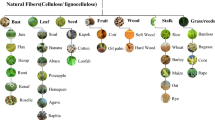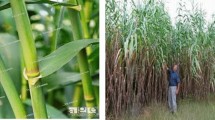Abstract
In recent years, rapid economic development and urbanization have led to severe environmental problems such as noise pollution. The use of fibrous porous materials is considered to be an effective method to control noise pollution. This study investigates the morphological and acoustical characteristics of fibrous materials made of aluminosilicate fibers (ASFs). To this end, morphological and structural properties of samples were investigated using field emission scanning electron microscope (FE-SEM), X-ray diffraction (XRD), and Brunauer–Emmett–Teller (BET) method. The effect of sample thickness and air gap was experimentally studied using the impedance tube method in the frequency range of 63–6300 Hz. The frequency-dependent acoustic behavior of the samples was also predicted using the empirical models of Delany-Bazley (D-B), Garai-Pompoli (G-P), and the proposed revised models of D-B and G-P. The XRD patterns showed that the main phases of the ASF are quartz, tridymite, and mullite. The BET analysis confirmed that the samples are classified as macro-porous. It was found that with the increase of the sample thickness sound absorption coefficient (SAC) increases at low frequencies. The averages of SACs for samples with thicknesses of 10 and 25 mm at low frequencies were 0.17 and 0.32, respectively. These values for the middle frequencies were 0.78 and 0.80, and for high frequencies were 0.83 and 0.84, respectively. Additionally, it was observed that with the increase of air gap depth, SAC enhances at low-frequency bands, and the SAC peak shifts toward the lower frequencies. Additionally, excellent agreement was observed between the experimentally measured SACs and those predicted by the revised D-B and G-P models.







Similar content being viewed by others
References
Abdi DD, Monazzam M, Taban E, Putra A, Golbabaei F, Khadem M (2021) Sound absorption performance of natural fiber composite from chrome shave and coffee silver skin. Appl Acoust 182:108264. https://doi.org/10.1016/j.apacoust.2021.108264
Abedkarimi R, Hasani H, Soltani P, Talebi Z (2020) Experimental and computational analysis of acoustic characteristics of warp-knitted spacer fabrics. J Text Inst 111(4):491–498
Ahmed S, Gadelmoula A (2020) Industrial noise monitoring using noise map** technique: a case study on a concrete block-making factory. Int J Environ Sci Technol, 1–12
ASTM S (1990) Standard test method for sound absorption and sound absorption coefficients by the reverberation room method. C423–90a
Astrauskas T, Picó R, Sánchez-Morcillo V, Grubliauskas R (2021) Acoustic panels based on recycled paper sludge and lime composites. Int J Environ Sci Technol 1–8
Berardi U, Iannace G (2015) Acoustic characterization of natural fibers for sound absorption applications. Build Environ 94:840–852. https://doi.org/10.1016/j.buildenv.2015.05.029
Berardi U, Iannace G (2017) Predicting the sound absorption of natural materials: best-fit inverse laws for the acoustic impedance and the propagation constant. Appl Acoust 115:131–138. https://doi.org/10.1016/j.apacoust.2016.08.012
Bies D, Hansen CH (1980) Flow resistance information for acoustical design. Appl Acoust 13(5):357–391
Brooke DC, Umnova O, Leclaire P, Dupont T (2020) Acoustic metamaterial for low frequency sound absorption in linear and nonlinear regimes. J Sound Vib 485:115585
Cao L, Fu Q, Si Y, Ding B, Yu J (2018) Porous materials for sound absorption. Compos Commun 10:25–35. https://doi.org/10.1016/j.coco.2018.05.001
Cox T, d’Antonio P (2016) Acoustic absorbers and diffusers: theory, design and application. Crc Press
Cuiyun D, Guang C, **nbang X, Peisheng L (2012) Sound absorption characteristics of a high-temperature sintering porous ceramic material. Appl Acoust 73(9):865–871. https://doi.org/10.1016/j.apacoust.2012.01.004
Davar H, Taghavirad S, Mohammadi M (2014) The investigation of effects of silica on the environment and prevention of release of the silica particles with simulation of gas-solid flow in a gas cyclone. Res J Chem Environ 18(11):28–30
Delany ME, Bazley EN (1970) Acoustical properties of fibrous absorbent materials. Appl Acoust 3(2):105–116. https://doi.org/10.1016/0003-682X(70)90031-9
Dunne R, Desai D, Sadiku R (2017) A review of the factors that influence sound absorption and the available empirical models for fibrous materials. Acoust Aust 45(2):453–469. https://doi.org/10.1007/s40857-017-0097-4
Everest FA, Pohlmann KC (2015). Master handbook of acoustics
Francis CD, Barber JR (2013) A framework for understanding noise impacts on wildlife: an urgent conservation priority. Front Ecol Environ 11(6):305–313. https://doi.org/10.1890/120183
Garai M, Pompoli F (2005) A simple empirical model of polyester fibre materials for acoustical applications. Appl Acoust 66(12):1383–1398. https://doi.org/10.1016/j.apacoust.2005.04.008
Ghermezgoli ZM, Moezzi M, Yekrang J, Rafat SA, Soltani P, Barez F (2021) Sound absorption and thermal insulation characteristics of fabrics made of pure and crossbred sheep waste wool. J Build Eng 35:102060
Hajimohammadi M, Soltani P, Semnani D, Taban E, Fashandi H (2022) Nonwoven fabric coated with core-shell and hollow nanofiber membranes for efficient sound absorption in buildings. Build Environ. https://doi.org/10.1016/j.buildenv.2022.108887
Hassani P, Soltani P, Ghane M, Zarrebini M (2021) Porous resin-bonded recycled denim composite as an efficient sound-absorbing material. Appl Acoust 173:107710. https://doi.org/10.1016/j.apacoust.2020.107710
He M, Perrot C, Guilleminot J, Leroy P, Jacqus G (2018) Multiscale prediction of acoustic properties for glass wools: computational study and experimental validation. J Acoust Soc Am 143(6):3283–3299
Herr AE, Canumalla S, Pangborn RN (1995) Thermal fatigue behavior of squeeze cast, discontinuous alumina-silicate fiber-reinforced aluminum alloy (A356) composite. Mater Sci Eng A 200(1):181–191. https://doi.org/10.1016/0921-5093(95)07004-4
Institution BS (1993) Acoustics. Materials for acoustical applications. Determination of airflow resistance. British Standards Institution
International standard ISO 10534–2 (1998) Acoustics-determination of sound absorption coefficient and impedance in impedance tubes—part 2: transfer-function method
Jeon JH, Yang SS, Kang YJ (2020) Estimation of sound absorption coefficient of layered fibrous material using artificial neural networks. Appl Acoust 169:107476
Jiang R, Liu H, Yang L, Sun X, Cheng H (2018) Mechanical properties of aluminosilicate fiber heat-treated from 800 °C to 1400 °C: effects of phase transition, grain growth and defects. Mater Charact 138:120–126. https://doi.org/10.1016/j.matchar.2018.01.047
Karimi F, Soltani P, Zarrebini M, Hassanpour A (2022) Acoustic and thermal performance of polypropylene nonwoven fabrics for insulation in buildings. J Build Eng 50:104125. https://doi.org/10.1016/j.jobe.2022.104125
Lim Z, Putra A, Nor M, Yaakob M (2018) Sound absorption performance of natural kenaf fibres. Acoust Aust 130:107–114
Maderuelo-Sanz R (2021) Characterizing and modelling the sound absorption of the cellulose acetate fibers coming from cigarette butts. J Environ Health Sci Eng 19(1):1075–1086
Maderuelo-Sanz R, Acedo-Fuentes P, García-Cobos FJ, Sánchez-Delgado FJ, Mota-López MI, Meneses-Rodríguez JM (2021) The recycling of surgical face masks as sound porous absorbers: preliminary evaluation. Sci Total Environ 786:147461
Maxim LD, Utell MJ (2014) Aluminosilicate fibers. In: Wexler P (ed) Encyclopedia of toxicology, 3rd edn. Academic Press, Oxford, pp 156–160
Mehrzad S, Taban E, Soltani P, Samaei SE, Khavanin A (2022) Sugarcane bagasse waste fibers as novel thermal insulation and sound-absorbing materials for application in sustainable buildings. Build Environ 211:108753
Miskinis K, Dikavicius V, Buska A, Banionis K (2018) Influence of EPS, mineral wool and plaster layers on sound and thermal insulation of a wall: a case study. Appl Acoust 137:62–68
Mohammadi MJ, Charkhloo E, Geravandi S, Takdastan A, Rahimi S, Yari AR et al (2017) Road traffic noise in urban environments in Ahvaz city, Iran. Fresenius Environ Bull 26(4):2746–2751
Moretti E, Belloni E, Agosti F (2016) Innovative mineral fiber insulation panels for buildings: thermal and acoustic characterization. Appl Energy 169:421–432. https://doi.org/10.1016/j.apenergy.2016.02.048
Sakthivel S (2021) Studies on influence of bonding methods on sound absorption characteristic of polyester/cotton recycled nonwoven fabrics. Appl Acoust 174:107749
Samaei E, Berardi U, Taban E, Soltani P, Mohammad Mousavi S (2021a) Natural fibro-granular composite as a novel sustainable sound-absorbing material. Appl Acoust 181:108157. https://doi.org/10.1016/j.apacoust.2021.108157
Samaei SE, Berardi U, Soltani P, Taban E (2021b) Experimental and modeling investigation of the acoustic behavior of sustainable kenaf/yucca composites. Appl Acoust 183:108332. https://doi.org/10.1016/j.apacoust.2021.108332
Samaei SE, Berardi U, Taban E, Soltani P, Mousavi SM (2021c) Natural fibro-granular composite as a novel sustainable sound-absorbing material. Appl Acoust 181:108157
Soltani P, Norouzi M (2020) Prediction of the sound absorption behavior of nonwoven fabrics: computational study and experimental validation. J Sound Vib 485:115607
Soltani P, Taban E, Faridan M, Samaei SE, Amininasab S (2020) Experimental and computational investigation of sound absorption performance of sustainable porous material: Yucca Gloriosa fiber. Appl Acoust 157:106999
Sun Z, Shen Z, Ma S, Zhang X (2015) Sound absorption application of fiberglass recycled from waste printed circuit boards. Mater Struct 48(1):387–392
Taban E, Khavanin A, Faridan M, Samaei SE, Samimi K, Rashidi R (2020) Comparison of acoustic absorption characteristics of coir and date palm fibers: experimental and analytical study of green composites. Int J Environ Sci Technol 17:39–48. https://doi.org/10.1007/s13762-019-02304-8
Taban E, Amininasab S, Berardi U, Abdi DD, Samaei SE (2021a) Use of date palm waste fibers as sound absorption material. J Build Eng 41:102752
Taban E, Amininasab S, Soltani P, Berardi U, Abdi DD, Samaei SE (2021b) Use of date palm waste fibers as sound absorption material. J Build Eng 41:102752. https://doi.org/10.1016/j.jobe.2021.102752
Taban E, Valipour F, Abdi DD, Amininasab S (2021c) Mathematical and experimental investigation of sound absorption behavior of sustainable kenaf fiber at low frequency. Int J Environ Sci Technol 18(9):2765–2780. https://doi.org/10.1007/s13762-020-03024-0
Tang X, Yan X (2017) Acoustic energy absorption properties of fibrous materials: a review. Compos A Appl Sci Manuf 101:360–380. https://doi.org/10.1016/j.compositesa.2017.07.002
Tsai K-T, Lin M-D, Lin Y-H (2019) Noise exposure assessment and prevention around high-speed rail. Int J Environ Sci Technol 16(8):4833–4842
Wang Y, Zhang C, Ren L, Ichchou M, Galland M-A, Bareille O (2013) Influences of rice hull in polyurethane foam on its sound absorption characteristics. Polym Compos 34(11):1847–1855. https://doi.org/10.1002/pc.22590
Wang F, Chen Z, Wu C, Yang Y (2019) Prediction on sound insulation properties of ultrafine glass wool mats with artificial neural networks. Appl Acoust 146:164–171
Yang T, Saati F, Horoshenkov KV, **ong X, Yang K, Mishra R et al (2019) Study on the sound absorption behavior of multi-component polyester nonwovens: experimental and numerical methods. Text Res J 89(16):3342–3361
Yang T, Hu L, **ong X, Petrů M, Noman MT, Mishra R et al (2020) Sound absorption properties of natural fibers: a review. Sustainability. https://doi.org/10.3390/su12208477
Zhang S, Li Y, Zheng Z (2018) Effect of physiochemical structure on energy absorption properties of plant fibers reinforced composites: dielectric, thermal insulation, and sound absorption properties. Compos Commun 10:163–167
Zhao X-D, Yu Y-J, Wu Y-J (2016) Improving low-frequency sound absorption of micro-perforated panel absorbers by using mechanical impedance plate combined with Helmholtz resonators. Appl Acoust 114:92–98. https://doi.org/10.1016/j.apacoust.2016.07.013
Acknowledgements
We are thankful to Mashhad University of medical sciences for providing the necessary laboratory facilities for this work. The authors would like to appreciate the financial support provided by the university under grant no. of 991156.
Author information
Authors and Affiliations
Corresponding author
Ethics declarations
Conflict of Interest
The authors declare that there are no conflict of interest.
Additional information
Editorial responsibility: Maryam Shabani.
Rights and permissions
About this article
Cite this article
Soltani, P., Mirzaei, R., Samaei, E. et al. Sound absorption characteristics of aluminosilicate fibers. Int. J. Environ. Sci. Technol. 19, 10245–10256 (2022). https://doi.org/10.1007/s13762-022-04229-1
Received:
Revised:
Accepted:
Published:
Issue Date:
DOI: https://doi.org/10.1007/s13762-022-04229-1




